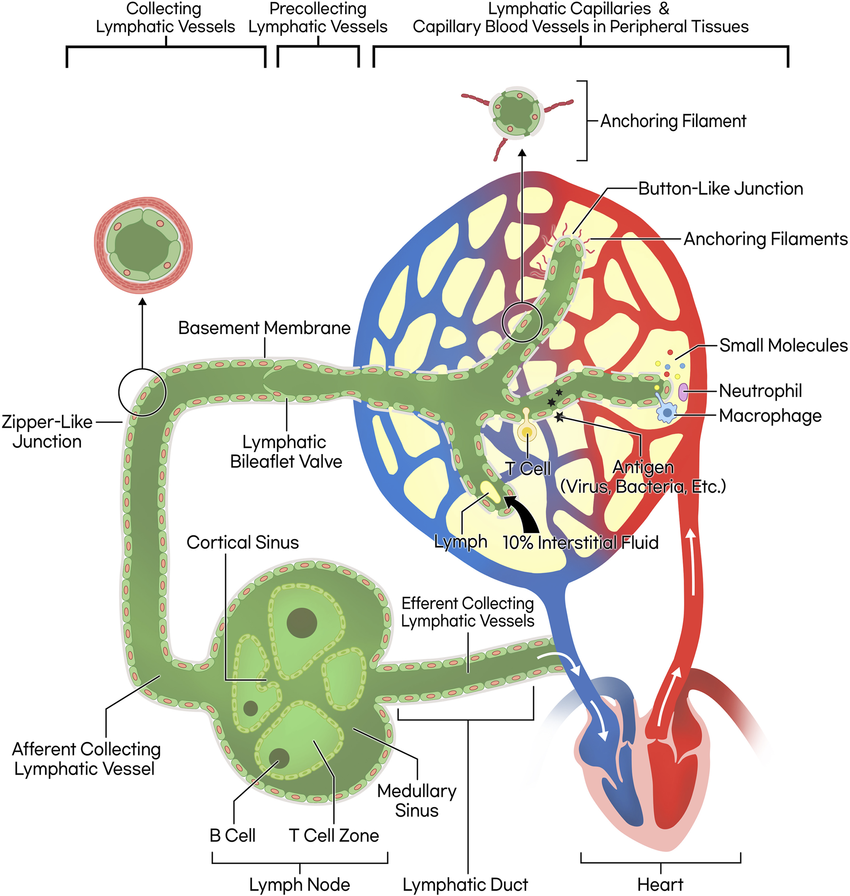Lymphatic vessels are a critical part of the lymphatic system, responsible for transporting lymph (a fluid containing white blood cells, proteins, and waste products) from tissues back into the bloodstream. These vessels form an extensive network throughout the body, functioning similarly to veins but with distinct structural and physiological differences.

The primary roles of lymphatic vessels include maintaining fluid balance, absorbing dietary fats, and supporting immune function by facilitating the movement of immune cells.
Structure of Lymphatic Vessels
Lymphatic vessels resemble veins in structure but have unique features that allow them to efficiently transport lymph. They have thin walls, contain valves to prevent backflow, and rely on external forces (like muscle contractions) for fluid movement.
Lymphatic vessels are composed of three layers:
- Tunica Intima – The innermost layer, made of endothelial cells, forms a one-way valve system that prevents lymph from flowing backward.
- Tunica Media – The middle layer, consisting of smooth muscle fibers, helps regulate lymph flow.
- Tunica Externa – The outermost layer, composed of connective tissue, provides structural support.
Unlike blood capillaries, lymphatic capillaries are more permeable, allowing large molecules like proteins, lipids, and immune cells to enter the lymphatic system.
Types of Lymphatic Vessels
Lymphatic vessels are classified into two main types:
1. Lymphatic Capillaries (Initial Lymphatics)
- These are the smallest lymphatic vessels, present in most tissues except the brain, spinal cord, bone marrow, and avascular tissues like cartilage and cornea.
- They are blind-ended (closed at one end) and have overlapping endothelial cells that function as one-way valves, allowing interstitial fluid to enter but preventing backflow.
- Lymphatic capillaries absorb excess interstitial fluid, proteins, and cellular debris, preventing fluid accumulation (edema).
- Specialized lymphatic capillaries in the small intestine, called lacteals, help absorb dietary fats and transport them as chyle to the bloodstream.
2. Larger Lymphatic Vessels
- These vessels collect lymph from capillaries and transport it toward lymph nodes and larger lymphatic trunks.
- They contain valves similar to veins, ensuring unidirectional flow toward the heart.
- Lymphatic vessels merge to form larger trunks and ducts, which ultimately return lymph to venous circulation.
Lymph Circulation Pathway
Lymphatic circulation begins at the tissue level and follows this pathway:
- Lymphatic Capillaries absorb interstitial fluid.
- Fluid moves into Larger Lymphatic Vessels that contain valves to prevent backflow.
- Lymph is filtered through Lymph Nodes, where immune cells detect pathogens and debris.
- Lymphatic vessels converge into Lymphatic Trunks, which drain lymph from specific body regions.
- Trunks empty into two major Lymphatic Ducts:
Right Lymphatic Duct → Drains lymph from the right upper limb, right thorax, and right head and neck into the right subclavian vein.
Thoracic Duct → The largest lymphatic vessel, draining lymph from the rest of the body into the left subclavian vein.
Once in the bloodstream, lymph fluid is recirculated and helps maintain fluid balance.
Functions of Lymphatic Vessels
Lymphatic vessels play a crucial role in maintaining homeostasis and immune defense. Their key functions include:
1. Fluid Homeostasis: Prevents tissue swelling (edema) by absorbing excess interstitial fluid.Returns fluid to the circulatory system, maintaining blood volume and pressure.
2. Immune Surveillance and Defense: Transports antigens and immune cells to lymph nodes for immune response activation.Helps detect and eliminate pathogens, foreign particles, and cancer cells.
3. Fat Absorption: Specialized lymphatic capillaries (lacteals) in the intestine absorb dietary fats and fat-soluble vitamins.Chyle (milky lymph containing fats) is transported to the bloodstream, aiding digestion.
4. Waste Removal: Removes cellular waste, toxins, and dead cells from tissues, preventing toxic accumulation.
Clinical Significance of Lymphatic Vessels
Dysfunction or blockage of lymphatic vessels can lead to various health conditions. Some important clinical aspects include:
1. Lymphedema: Caused by lymphatic obstruction, leading to fluid accumulation and swelling in tissues.Can occur due to surgery (e.g., after lymph node removal), infections, radiation therapy, or congenital defects.Filariasis, a parasitic infection, can cause elephantiasis, a severe form of lymphedema.
2. Lymphangitis: Inflammation of lymphatic vessels, usually due to bacterial infection (e.g., Streptococcus or Staphylococcus).Symptoms include red streaks on the skin, fever, and swollen lymph nodes.
3. Cancer Metastasis: Lymphatic vessels play a role in cancer spread (metastasis), as cancer cells can enter lymphatics and travel to distant organs.Lymph node biopsy is used to detect cancer spread in conditions like breast cancer and melanoma.
4. Chylothorax: Leakage of chyle (lymph rich in fats) into the pleural cavity due to lymphatic injury or blockage.Can occur due to trauma, tumors, or surgery near the thoracic duct.
5. Lymphatic Insufficiency: Can lead to immune system deficiencies due to impaired transport of immune cells and antigens.
Conclusion
Lymphatic vessels are an essential part of the lymphatic system, functioning as a transport network for lymph fluid, immune cells, and dietary fats. Their specialized structure allows them to maintain fluid balance, immune surveillance, and waste removal. Proper functioning of lymphatic vessels is crucial for immune defense, preventing lymphedema, and supporting overall health. Dysfunction in these vessels can lead to serious medical conditions, making them a key area of study in immunology, oncology, and vascular medicine.

